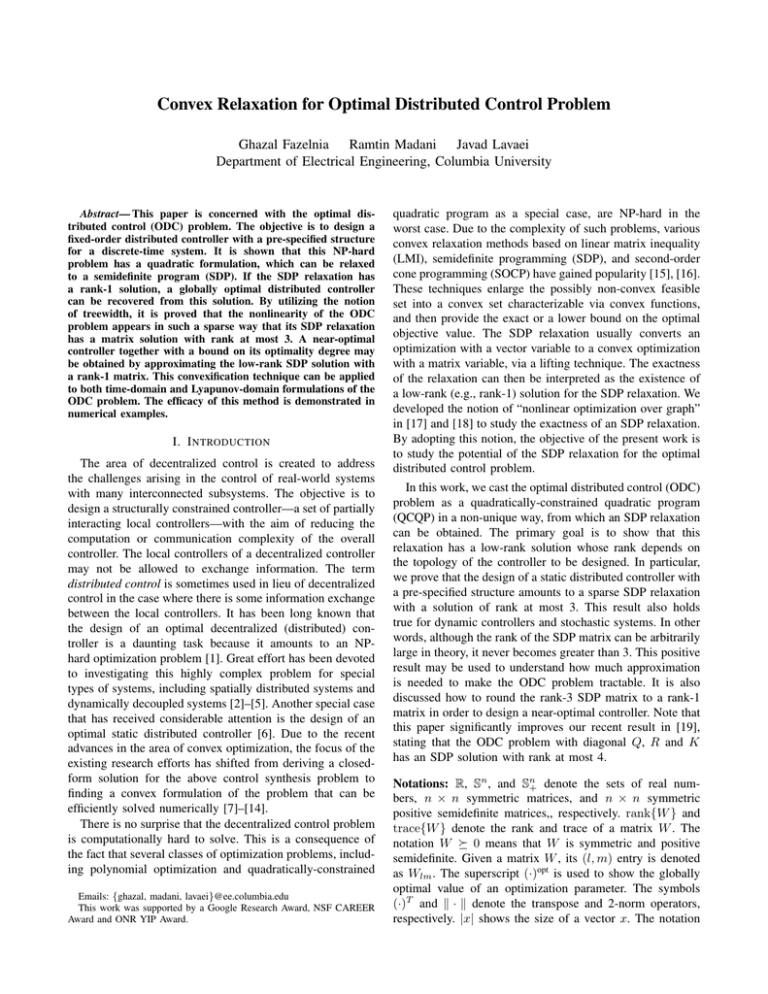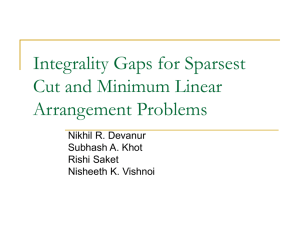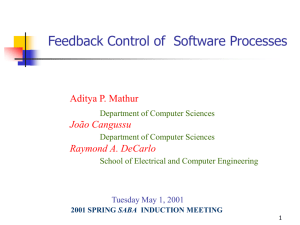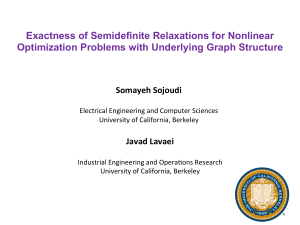Convex Relaxation for Optimal Distributed Control Problem Ghazal Fazelnia Ramtin Madani Javad Lavaei
advertisement

Convex Relaxation for Optimal Distributed Control Problem
Ghazal Fazelnia Ramtin Madani Javad Lavaei
Department of Electrical Engineering, Columbia University
Abstract— This paper is concerned with the optimal distributed control (ODC) problem. The objective is to design a
fixed-order distributed controller with a pre-specified structure
for a discrete-time system. It is shown that this NP-hard
problem has a quadratic formulation, which can be relaxed
to a semidefinite program (SDP). If the SDP relaxation has
a rank-1 solution, a globally optimal distributed controller
can be recovered from this solution. By utilizing the notion
of treewidth, it is proved that the nonlinearity of the ODC
problem appears in such a sparse way that its SDP relaxation
has a matrix solution with rank at most 3. A near-optimal
controller together with a bound on its optimality degree may
be obtained by approximating the low-rank SDP solution with
a rank-1 matrix. This convexification technique can be applied
to both time-domain and Lyapunov-domain formulations of the
ODC problem. The efficacy of this method is demonstrated in
numerical examples.
I. I NTRODUCTION
The area of decentralized control is created to address
the challenges arising in the control of real-world systems
with many interconnected subsystems. The objective is to
design a structurally constrained controller—a set of partially
interacting local controllers—with the aim of reducing the
computation or communication complexity of the overall
controller. The local controllers of a decentralized controller
may not be allowed to exchange information. The term
distributed control is sometimes used in lieu of decentralized
control in the case where there is some information exchange
between the local controllers. It has been long known that
the design of an optimal decentralized (distributed) controller is a daunting task because it amounts to an NPhard optimization problem [1]. Great effort has been devoted
to investigating this highly complex problem for special
types of systems, including spatially distributed systems and
dynamically decoupled systems [2]–[5]. Another special case
that has received considerable attention is the design of an
optimal static distributed controller [6]. Due to the recent
advances in the area of convex optimization, the focus of the
existing research efforts has shifted from deriving a closedform solution for the above control synthesis problem to
finding a convex formulation of the problem that can be
efficiently solved numerically [7]–[14].
There is no surprise that the decentralized control problem
is computationally hard to solve. This is a consequence of
the fact that several classes of optimization problems, including polynomial optimization and quadratically-constrained
Emails: {ghazal, madani, lavaei}@ee.columbia.edu
This work was supported by a Google Research Award, NSF CAREER
Award and ONR YIP Award.
quadratic program as a special case, are NP-hard in the
worst case. Due to the complexity of such problems, various
convex relaxation methods based on linear matrix inequality
(LMI), semidefinite programming (SDP), and second-order
cone programming (SOCP) have gained popularity [15], [16].
These techniques enlarge the possibly non-convex feasible
set into a convex set characterizable via convex functions,
and then provide the exact or a lower bound on the optimal
objective value. The SDP relaxation usually converts an
optimization with a vector variable to a convex optimization
with a matrix variable, via a lifting technique. The exactness
of the relaxation can then be interpreted as the existence of
a low-rank (e.g., rank-1) solution for the SDP relaxation. We
developed the notion of “nonlinear optimization over graph”
in [17] and [18] to study the exactness of an SDP relaxation.
By adopting this notion, the objective of the present work is
to study the potential of the SDP relaxation for the optimal
distributed control problem.
In this work, we cast the optimal distributed control (ODC)
problem as a quadratically-constrained quadratic program
(QCQP) in a non-unique way, from which an SDP relaxation
can be obtained. The primary goal is to show that this
relaxation has a low-rank solution whose rank depends on
the topology of the controller to be designed. In particular,
we prove that the design of a static distributed controller with
a pre-specified structure amounts to a sparse SDP relaxation
with a solution of rank at most 3. This result also holds
true for dynamic controllers and stochastic systems. In other
words, although the rank of the SDP matrix can be arbitrarily
large in theory, it never becomes greater than 3. This positive
result may be used to understand how much approximation
is needed to make the ODC problem tractable. It is also
discussed how to round the rank-3 SDP matrix to a rank-1
matrix in order to design a near-optimal controller. Note that
this paper significantly improves our recent result in [19],
stating that the ODC problem with diagonal Q, R and K
has an SDP solution with rank at most 4.
Notations: R, Sn , and Sn+ denote the sets of real numbers, n × n symmetric matrices, and n × n symmetric
positive semidefinite matrices,, respectively. rank{W } and
trace{W } denote the rank and trace of a matrix W . The
notation W ≽ 0 means that W is symmetric and positive
semidefinite. Given a matrix W , its (l, m) entry is denoted
as Wlm . The superscript (·)opt is used to show the globally
optimal value of an optimization parameter. The symbols
(·)T and ∥ · ∥ denote the transpose and 2-norm operators,
respectively. |x| shows the size of a vector x. The notation
G = (V, E) denotes as a graph G with the vertex set V and
the edge set E.
II. P ROBLEM FORMULATION
Consider the discrete-time system
{
x[τ + 1] = Ax[τ ] + Bu[τ ]
y[τ ] = Cx[τ ]
τ = 0, 1, ..., p
(1)
with the known parameters A ∈ Rn×n , B ∈ Rn×m , C ∈
Rr×n , and x[0] ∈ Rn . The goal is to design a decentralized
(distributed) controller minimizing a quadratic cost function.
With no loss of generality, we focus on the static case
where the objective is to design a static controller of the
form u[τ ] = Ky[τ ] under the constraint that the controller
gain K must belong to a given linear subspace K ⊆ Rm×r
(see Section VI for various extensions). The set K captures
the sparsity structure of the unknown constrained controller
u[τ ] = Ky[τ ] and, more specifically, it contains all m × r
real-valued matrices with forced zeros in certain entries. This
paper is mainly concerned with the following problem.
Optimal Distributed Control (ODC) problem: Design a
static controller u[τ ] = Ky[τ ] to minimize the cost function
p
∑
(
)
x[τ ]T Qx[τ ] + u[τ ]T Ru[τ ] + α trace{KK T }
(2)
τ =0
subject to the system dynamics (1) and the controller requirement K ∈ K, given the terminal time p, positive-definite
matrices Q and R, and a constant α.
Note that the third term in the objective function of the
ODC problem is a soft penalty term aimed at avoiding a
high-gain controller.
III. SDP R ELAXATION FOR Q UADRATIC O PTIMIZATION
The objective of this section is to study the SDP relaxation
of a QCQP problem using a graph-theoretic approach. Before
proceeding with this part, some notions in graph theory will
be reviewed.
A. Graph Theory Preliminaries
Definition 1: For two simple graphs G1 = (V1 , E1 ) and
G2 = (V2 , E2 ), the notation G1 ⊆ G2 means that V1 ⊆ V2
and E1 ⊆ E2 . G1 is called a subgraph of G2 and G2 is called
a supergraph of G1 .
Definition 2 (Treewidth): Given a graph G = (V, E), a
tree T is called a tree decomposition of G if it satisfies the
following properties:
1) Every node of T corresponds to and is identified by a
subset of V. Alternatively, each node of T is regarded
as a group of vertices of G.
2) Every vertex of G is a member of at least one node
of T .
3) Tk is a connected graph for every k ∈ V, where Tk
denotes the subgraph of T induced by all nodes of T
containing the vertex k of G.
4) The subgraphs Ti and Tj have a node in common for
every (i, j) ∈ E.
The width of a tree decomposition is the cardinality of
its biggest node minus one (recall that each node of T is
indeed a set containing a number of vertices of G). The
treewidth of G is the minimum width over all possible tree
decompositions of G and is denoted by tw(G).
Definition 3: The representative graph of an n × n symmetric matrix W , denoted by G(W ), is a simple graph with
n vertices whose edges are specified by the locations of
the nonzero off-diagonal entries of W . In other words, two
arbitrary vertices i and j are connected if Wij is nonzero.
Given a graph G accompanied by a tree decomposition T of
width t, there exists a supergraph of G with certain properties
that is called enriched supergraph of G derived by T . The
reader may refer to [20], [21] for a precise definition.
B. SDP Relaxation
Consider the standard nonconvex QCQP problem
min
x∈Rn
s.t.
f0 (x)
(3a)
fk (x) ≤ 0
for
k = 1, . . . , p
(3b)
where fk (x) = xT Ak x + 2bTk x + ck for k = 0, . . . , p. Define
[
]
ck bTk
Fk ,
and w , [x0 xT ]T ,
(4)
bk Ak
where x0 =1. Given k ∈ {0, 1, ..., p}, the function fk (x)
is a homogeneous polynomial of degree 2 with respect to
w. Hence, fk (x) has a linear representation as fk (x) =
trace{Fk W }, where
W , wwT
(5)
Conversely, an arbitrary matrix W ∈ Sn+1 can be factorized
as (5) with w1 = 1 if and only if it satisfies the three
properties: W11 = 1, W ≽ 0, and rank{W } = 1. Therefore,
the general QCQP (3) can be reformulated as below:
min
trace{F0 W }
s.t.
trace{Fk W } ≤ 0
W11 = 1
W ∈Sn+1
(6a)
for
k = 1, . . . , p
W ≽0
rank{W } = 1.
(6b)
(6c)
(6d)
(6e)
This optimization is called a rank-constrained formulation
of the QCQP (3). In the above representation of QCQP,
the constraint (6e) carries all the nonconvexity. Neglecting
this constraint yields a convex problem, which is called an
SDP relaxation of the QCQP (3). The existence of a rank-1
solution for the SDP relaxation guarantees the equivalence
between the original QCQP and its relaxed problem.
C. Connection Between Rank and Sparsity
To explore the rank of the minimum-rank solution of the
SDP relaxation, define G = G(F0 ) ∪ · · · ∪ G(Fp ) as the
sparsity graph associated with the rank-constrained problem (6). The graph G describes the zero-nonzero pattern of
the matrices F0 , . . . , Fp , or alternatively captures the sparsity
level of the QCQP problem (3). The graph G = (V, E) has
the following properties:
1) Each vertex of V corresponds to one of the entries
of w or equivalently one of the elements of the set
{x0 , x1 , ..., xn } (note that x0 = 1). Let the vertex
associated with the variable xi be denoted as vxi for
i = 0, 1, ..., n.
2) Given two distinct indices i, j ∈ {0, 1, . . . , n}, the pair
(vxi , vxj ) is an edge of G if and only if the monomial
xi xj has a nonzero coefficient in at least one of the
polynomials f0 (x), f1 (x), . . . , fp (x).
Let Ḡ be an enriched supergraph of G with n̄ vertices that
is obtained from a tree decomposition of width t (note that
n̄ ≥ n).
c ∈ Sn+ to
Theorem 1: Consider an arbitrary solution W
n̄
the SDP relaxation of (6) and let Z ∈ S be a matrix with
opt
the property that G(Z) = Ḡ. Let W
denote an arbitrary
solution of the optimization
min trace{ZW }
(7a)
W ∈Sn̄
ckk
s.t. W kk = W
W kk = 1
cij
W ij = W
W ≽ 0.
for k = 0, 1, ..., n,
(7b)
for
(7c)
k = n + 1, ..., n̄,
for (i, j) ∈ EG ,
(7d)
(7e)
opt
Define W opt ∈ Sn+1 as a matrix obtained from W
by
deleting the last n̄ − n − 1 rows and n̄ − n − 1 columns.
Let t denote the treewidth of the graph. If there exists a
positive definite matrix W satisfying the constraints of the
above optimization, then W opt has two properties:
a) W opt is an optimal solution to the SDP relaxation of (6).
b) rank{W opt } ≤ t + 1.
Proof: See [20] for the proof.
Assume that a tree decomposition of G with a small width
is known. Theorem 1 states that an arbitrary (high-rank)
solution to the SDP relaxation problem can be transformed
into a low-rank solution by solving the convex program (7).
Note that the above theorem requires the existence of a
positive-definite feasible point, but this assumption can be
removed after a small modification to (7) (see [20]).
IV. Q UADRATIC F ORMULATIONS OF ODC P ROBLEM
The primary objective of the ODC problem is to design a
structurally constrained gain K. Assume that the matrix K
has l free entries to be designed. Denote these parameters as
h1 , h2 , ..., hl . To formulate the ODC problem, the space of
permissible controllers can be characterized as
{ l
}
∑
l
K,
hi Mi h ∈ R ,
(8)
i=1
for some (fixed) 0-1 matrices M1 , ..., Ml ∈ Rm×r . Now, the
ODC problem can be stated as follows.
ODC Problem: Minimize
p
∑
(
)
x[τ ]T Qx[τ ] + u[τ ]T Ru[τ ] + α trace{KK T } (9a)
τ =0
subject to
x[τ + 1] = Ax[τ ] + Bu[τ ]
y[τ ] = Cx[τ ]
for τ = 0, 1, . . . , p (9b)
for τ = 0, 1, . . . , p (9c)
u[τ ] = Ky[τ ]
for
K = h1 M1 + . . . + hl Ml
τ = 0, 1, . . . , p (9d)
(9e)
x[0] = given
(9f)
over the variables
x[0], x[1], . . . , x[p] ∈ Rn
y[0], y[1], . . . , y[p] ∈ Rr
u[0], u[1], . . . , u[p] ∈ Rm
(9g)
(9h)
(9i)
h ∈ Rl .
(9j)
To cast the ODC problem as a quadratic optimization, define
[
]T
[
]T
wd , z hT xT uT , ws , z hT xT uT y T
(10)
where
[
]T
x , x[0]T · · · x[p]T
[
]T
u , u[0]T · · · u[p]T
]T
[
y , y[0]T · · · y[p]T ,
(11a)
(11b)
(11c)
and z is a scalar auxiliary variable playing the role of
number 1 (equivalently, the quadratic constraint z 2 = 1 can
be posed instead of z = 1 without affecting the solution).
The objective and constraints of the ODC problems are all
homogeneous functions of ws with degree 2. For example,
(9c) is equivalent to z × y[τ ] − C × z × x[τ ] = 0, which is a
second-order equality constraint. Hence, the ODC problem
can be cast as a QCQP with a sparsity graph G, where the
vertices of G correspond to the entries of ws . In particular,
the vertex set VG can be partitioned into five vertex subsets,
where subset 1 consists of a single vertex associated with
the variable z and subsets 2-5 correspond to the vectors x,
u, y and h, respectively.
Sparsity graph for diagonal Q, R, and K: Consider the
case where the matrices Q and R are diagonal and the
controller K to be designed needs to be diagonal as well. The
underlying sparsity graph G is drawn in Figure 1, where each
vertex of the graph is labeled by its corresponding variable.
To increase the readability of the graph, some edges of vertex
z are not shown in the picture. Indeed, z is connected to all
vertices corresponding to the elements of x, u and y. This
is due to the linear terms x[τ ], u[τ ] and y[τ ] in (9) that are
equivalent to z × x[τ ], z × u[τ ] and z × y[τ ].
Theorem 2: The sparsity graph of the ODC problem (9)
has treewidth 2 in the case of diagonal Q, R, and K.
Proof: It follows from the graph drawn in Figure 1
that removing vertex z from the sparsity graph G makes the
remaining subgraph acyclic. This implies that the treewidth
of G is at most 2. On the other hand, the treewidth cannot
be 1 in light of the cycles of the graph.
It follows from Theorems 1 and 2 that the SDP relaxation
of the ODC problem has a matrix solution with rank 1, 2 or
3 in the diagonal case.
2) A multiplication of the constraint (9b) to itself for two
different times τ1 and τ2 leads to a redundant quadratic
equation, which can be imposed on the problem.
The above modifications yield two dense ODC problems.
First Dense Formulation of ODC: Minimize
p
∑
(
)
x[τ ]T Qx[τ ] + u[τ ]T Ru[τ ] + α trace{KK T } (12a)
τ =0
subject to
x[τ + 1] = Ax[τ ] + Bu[τ ]
u[τ ] = KCx[τ ]
K = h1 M1 + . . . + hl Ml
Fig. 1:
Sparsity graph of the ODC problem for diagonal Q, R, and K
(some edges of vertex z are not shown to increase the legibility of the
graph).
x[0] = given
(12b)
(12c)
(12d)
(12e)
for every τ ∈ {0, 1, . . . , p}, and subject to
Sparsity graph for non-diagonal Q, R, and K: As can
be seen in Figure 1, there is no edge in the subgraph
of G corresponding to the entries of x, as long as Q is
diagonal. However, if Q has nonzero off-diagonal elements,
certain edges (and probably cycles) may be created in the
subgraph of G associated with the aggregate state x. Under
this circumstance, the treewidth of G could be much higher
than 2. The same argument holds for a non-diagonal R or
K.
A. Various Quadratic Formulations of ODC Problem
The ODC problem has been cast as a QCQP in (9)
although it has infinitely many quadratic formulations. Since
every QCQP formulation of the ODC problem will be
ultimately convexified in this work, the following question
arises: what QCQP formulation of the ODC problem has a
better SDP relaxation? Note that two important factors for an
SDP relaxation are: (i) optimal objective value of the ODC
problem serving as a lower bound on the globally optimal
cost of the ODC problem, and (ii) the rank of the minimumrank solution of the SDP relaxation. By taking these two
factors into account, four different quadratic formulations of
the ODC problem will be proposed below.
Consider an arbitrary QCQP formulation of the ODC problem. Assume that it is possible to design a set of redundant
quadratic constraints whose addition to the QCQP problem
would not affect its feasible set. These redundant constraints
may lead to the shrinkage of the feasible set of the SDP
relaxation of the original QCQP problem, leading to a tighter
lower bound on the optimal cost of the ODC problem. More
precisely, reducing the unnecessary (dependent) parameters
of the QCQP problem and yet imposing additional redundant
constraints help with Factor (i) mentioned above. Roughly
speaking, this requires designing a quadratic formulation
whose edge set is as large as possible. To this end, two
modifications can be made on the QCQP problem (9):
1) The constraints (9c) and (9d) can be combined into a
single equation u[τ ] = KCx[τ ] and accordingly the
variables y[0], y[1], . . . , y[p] can be removed from the
optimization.
x[τ1 + 1]x[τ2 + 1]T = (Ax[τ1 ] + Bu[τ1 ])
× (Ax[τ2 ] + Bu[τ2 ])T ,
(12f)
x[τ1 + 1](Ax[τ2 ] + Bu[τ2 ])T = (Ax[τ1 ] + Bu[τ1 ])
× x[τ2 + 1]T
(12g)
for every τ1 , τ2 ∈ {0, 1, . . . , p}, over the optimization variables (9g), (9i) and (9j).
First Dense Formulation of ODC is a QCQP problem with
a dense sparsity graph. Note that the redundant constraints
(12f) and (12g) impose a high number of constraints on the
entries of the associated SDP matrix W , leading to a possible
shrinkage of the feasible set of the SDP relaxation. The SDP
relaxation of First Dense Formulation of ODC aims to offer a
good lower bound on the optimal cost of the ODC problem,
but the rank of its SDP solution may be high. To reduce the
rank, Theorem 1 suggests designing a quadratic formulation
whose sparsity graph has a lower treewidth.
Second Dense Formulation of ODC: This optimization
is obtained from First Dense Formulation of ODC (12) by
dropping its redundant constraints (12f) and (12g).
As discussed before, non-diagonal Q and R result in a
sparsity graph with a large treewidth. To remedy this issue,
define a new set of variables as follows:
x̄[τ ] , Qd x[τ ],
ū[τ ] , Rd u[τ ],
where Qd ∈ R
and Rd ∈ R
eigenvector matrices of Q and R, i.e.,
n×n
m×m
Q = QTd ΛQ Qd ,
(14)
are the respective
R = RdT ΛR Rd ,
(15)
where ΛQ ∈ Rn×n and ΛR ∈ Rm×m are diagonal matrices.
Define also
Ā , Qd AQTd ,
B̄ , Qd BRdT ,
C̄1 , CQTd .
(16)
The ODC problem can be reformulated as below.
First Sparse Formulation of ODC: Minimize
p
∑
(
)
x̄[τ ]T ΛQ x̄[τ ] + ū[τ ]T ΛR ū[τ ] + α trace{KK T }
τ =0
(17a)
subject to
x̄[τ + 1] = Āx̄[τ ] + B̄ ū[τ ]
y[τ ] = C̄1 x̄[τ ]
(17b)
(17c)
ū[τ ] = Rd Ky[τ ]
K = h1 M1 + . . . + hl Ml
(17d)
(17e)
x[0] = given
(17f)
for τ = 0, 1, . . . , p, over the optimization variables
x̄[0], x̄[1], . . . , x̄[p] ∈ Rn
(17g)
y[0], y[1], . . . , y[p] ∈ Rr
ū[0], ū[1], . . . , ū[p] ∈ Rm
(17h)
(17i)
h ∈ Rl .
(17j)
By comparing the objective functions of First Sparse
Formulation of ODC and First/Second Dense Formulation
of ODC, it can be concluded that the arbitrary matrices Q
and R have been substituted by two diagonal matrices ΛQ
and ΛR . It is straightforward to verify that the treewidth of
the sparsity graph of First Sparse Formulation of ODC is
dependent only on the sparsity level of the to-be-designed
controller K. To remedy this drawback, notice that there
exist constant binary matrices Φ1 ∈ Rm×l and Φ2 ∈ Rl×r
such that
{
}
K = Φ1 diag{h}Φ2 | h ∈ Rl ,
(18)
where diag{h} denotes a diagonal matrix whose diagonal
entries are inherited from the vector h [22]. Now, define
ȳ[τ ] , Φ2 y[τ ]
C̄2 ,
Φ2 CQTd .
(19a)
(19b)
The constraints (9c), (9d) and (9e) are equivalent to ȳ[τ ] =
C̄2 x̄[τ ] and ū[τ ] = Φ1 diag{h}ȳ[τ ]. Hence, the matrix K can
be diagonalized in the ODC problem as follows.
Second Sparse Formulation of ODC: Minimize
p
∑
x̄[τ ]T ΛQ x̄[τ ] + ū[τ ]T ΛR ū[τ ] + α hT h
(20a)
τ =0
subject to
x̄[τ + 1] = Āx̄[τ ] + B̄ ū[τ ]
ȳ[τ ] = C̄2 x̄[τ ]
ū[τ ] = Rd Φ1 diag{h}ȳ[τ ]
x̄[0] = given
(20b)
(20c)
(20d)
(20e)
for τ = 0, 1, . . . , p, over the variables (17g), (17i), (17j) and
ȳ[0], ȳ[1], . . . , ȳ[p] .
It should be mentioned that First Sparse Formulation of
ODC (17), Second Sparse Formulation of ODC (20) and the
ODC problem (9) are not only equivalent but also identical
in the case of diagonal Q, R, and K.
Theorem 3: The sparsity graph of Second Sparse Formulation of ODC (20) has treewidth 2.
Proof: The proof is omitted due to its similarity to the
proof of Theorem 2.
So far, four equivalent formulations of the ODC problem
have been introduced. In the next section, the SDP relaxations of these formulations will be contrasted with each
other.
V. SDP R ELAXATIONS OF ODC P ROBLEM
To streamline the presentation, the proposed formulations
of the ODC problem will be renamed as:
• Problem D-1: First Dense Formulation of ODC
• Problem D-2: Second Dense Formulation of ODC
• Problem S-1: First Sparse Formulation of ODC
• Problem S-2: Second Sparse Formulation of ODC
As mentioned earlier, each of these problems is a QCQP
formulation of the ODC problem. Hence, the technique
delineated in Subsection III-B can be deployed to obtain an
SDP relaxation for each of these problems. Let WD1 , WD2 ,
WS1 and WS2 denote the variables of the SDP relaxations of
Problems D-1, D-2, S-1 and S-2, respectively. The exactness
of the SDP relaxation for Problem D-1 is tantamount to the
opt
existence of an optimal rank-1 matrix WD
. In this case, an
1
opt
optimal vector wd for the ODC problem can be recovered
opt
by decomposing WD
as (wdopt )(wdopt )T (note that wd has
1
been defined in (10)). A similar argument holds for Problems
D-2, S-1 and S-2. The following observations can be made
here:
• The computational complexity of a convex optimization
problem, in the worst case, is related to the number of
variables as well as the number of constraints of the
problem. Under this measure of complexity, the SDP
relaxation of Problem D-2 is simpler (easier to solve)
than those of Problems D-1, S-1 and S-2. Similarly, the
SDP relaxation of Problem S-1 is simpler than that of
Problem S-2. It is expected that the SDP relaxation of
Problem D-1 has the highest complexity among all four
SDP relaxations.
• An SDP relaxation provides a lower bound on the
optimal cost of the ODC problem. It is justifiable that
the lower bounds obtained from Problems D-1, D-2,
S-1 and D-2 form a descending sequence. This implies
that Problem D-1 may offer the best lower bound on the
globally optimal cost of the ODC problem. On the other
hand, the treewidths of the sparsity graphs of Problems
D-1, D-2, S-1 and D-2 would form a descending sequence as well. Hence, in light of Theorem 1, Problem
S-2 may offer the best low-rank SDP solution.
Corollary 1: The SDP relaxation of Second Sparse Formulation of ODC has a matrix solution with rank at most 3.
Proof: This corollary is an immediate consequence of
Theorems 2 and 3.
Although Problem D-1 may offer the tightest lower bound
in theory, Problem S-2 has a guaranteed low-rank SDP
solution. A question arises as to which of the Problems D-1,
D-2, S-1 and S-2 should be convexified? We have analyzed
these problems for several thousand random systems with
random control structures and observed that:
The SDP relaxation of Problem D-1 often has highrank solutions and is also computationally expensive to
solve.
• The SDP relaxations of Problems D-1, D-2, S-1 and S-2
result in very similar lower bounds in almost all cases.
To support this statement, the optimal values of the four
SDP relaxations are plotted for 100 random systems in
the technical report [21].
Based on the above observations, the transition from the
highly-dense Problem D-1 to the highly-sparse Problem S2 may change the optimal SDP cost insignificantly but
improves the rank of the SDP solution dramatically (note
that the sizes of the SDP matrices for these two problems
are different).
•
order to convexify the above ODC problem, define a vector
w as
[
]T
w = 1 hT xT uT y T zcT
(22)
where zc is a column vector consisting of the entries of
zc [0], ..., zc [p], and h denotes a vector including all free
(nonzero) entries of the matrices Ac , Bc , Cc , and Dc . The
ODC problem can be cast as a quadratic optimization with
respect to the vector w, from which an SDP relaxation can be
derived. Hence, the results derived earlier can all be naturally
generalized to the above dynamic case.
Other extensions are to solve the ODC problem for p = ∞
and/or a stochastic system. The detail for these cases can be
found in [23], [24].
A. Rounding of SDP Solution to Rank-1 Matrix
Let W opt denote a low-rank SDP solution for one of the
above mentioned SDP relaxations. If the rank of this matrix
is 1, then W opt can be mapped back into a globally optimal
controller for the ODC problem through an eigenvalue decomposition W opt = wopt (wopt )T . If W opt has a rank greater
than 1, there are multiple approaches to recover a controller:
• A near-optimal controller may be obtained from the first
column of W opt corresponding to the controller part h.
opt
• First, W
is approximated by a rank-1 matrix by
means of the eigenvector associated with its largest
eigenvalue. Then, a near-optimal controller may be
constructed from the first column of this approximate
rank-1 matrix.
• Recall that the SDP relaxation was obtained by eliminating a rank constraint. In the case where this removal
changes the solution, one strategy is to compensate for
the rank constraint by incorporating an additive penalty
function, denoted as µ(W ), into the objective of the
SDP relaxation. A common penalty function µ(·) is
ε × trace{W }, where ε is a design parameter.
Note that by comparing the cost for the near-optimal controller with the lower bound obtained from the SDP relaxation, the optimality degree of the designed controller can
be assessed.
VI. E XTENSIONS
In the case of designing an optimal fixed-order dynamic
controller with a pre-specified structure, denote the unknown
controller as:
{
zc [τ + 1] = Ac zc [τ ] + Bc y[τ ]
(21)
u[τ ] = Cc zc [τ ] + Dc y[τ ]
where zc [τ ] ∈ Rnc represents the state of the controller, nc denotes its known degree, and the quadruple
(Ac , Bc , Cc , Dc ) needs to be designed. Since the controller is
required to have a pre-determined distributed structure, the
4-tuple (Ac , Bc , Cc , Dc ) must belong to a given polytope
K. This polytope enforces certain entries of Ac , Bc , Cc ,
and Dc to be zero. The above ODC problem is a nonlinear
optimization because the dynamics of the controller has some
unknown nonlinear terms such as Ac zc [τ ] and Bc y[τ ]. In
A. Computationally-Cheap SDP Relaxation
Although the proposed SDP relaxations are convex, it may
be difficult to solve them efficiently for a large-scale system.
This is due to the fact that the size of the SDP matrix depends
on the number of scalar variables at all times from 0 to p.
It is possible to significantly simplify the SDP relaxations.
For example, since the treewidth of the SDP relaxation
of Problem S-2 is equal to 2, the complicating constraint
WS2 ≽ 0 can be replaced by positive semidefinite constraints
on certain 3 × 3 submatrices of WS2 (those induced by
the nodes of the minimal tree decomposition of the sparsity
graph of Problem S-2) [20]. After this simplification of the
hard constraint WS2 ≽ 0, a quadratic number of entries
of WS2 turn out to be redundant (not appearing in any
constraint) and can be removed from the optimization.
There is a more efficient approach to derive a
computationally-cheap SDP relaxation. This will be explained below for the case where Q and R are non-singular
and r, m ≤ n.
With no loss of generality, we assume that C has full row
rank. There exists an invertible matrix Φ such that
CΦ =
[
I
0
]
(23)
where I is the identity matrix and “0” is an r × (n − r)
zero matrix. Define also K2 = {KK T | K ∈ K}. Indeed,
K2 captures the sparsity pattern of the matrix KK T . For example, if K consists of block-diagonal (rectangular) matrix,
K2 will also include block-diagonal (square) matrices. Let
µ ∈ R be a positive number such that
Q ≻ µ × Φ−T Φ−1
(24)
where Φ−T denotes the transpose of the inverse of Φ. Define
b := Q − µ × Φ−T Φ−1 .
Q
Computationally-Cheap SDP Relaxation: This optimization problem is defined as the minimization of
{
}
b + µ W22 + U T RU + α W33
trace X T QX
(25)
this end, we first discretize the system with the sampling
time of 0.4 second and denote the obtained system as
Fig. 2:
Mass-spring system with two masses
x[τ + 1] = Ax[τ ] + Bu[τ ],
(28)
It is aimed to design a constrained controller u[τ ] = Kx[τ ]
to minimize the cost function
subject to the constraints
x[τ + 1] = Ax[τ ] + Bu[τ ] for τ = 0, 1, . . . , p, (26a)
x[0] = given,
(26b)
[ T ]
K
In
Φ−1 X
0
(26c)
W :=
≽ 0,
T −T
T
W22
U
X Φ
[
]
K 0
U
W33
K ∈ K,
(26d)
W33 ∈ K2 ,
(26e)
with the optimization parameters
m×r
• K ∈R
[
]
n×(p+1)
• X = x[0] x[1] ... x[p] ∈ R
[
]
m×(p+1)
• U = u[0] u[1] ... u[p] ∈ R
n+m+p+1
• W ∈S
.
Note that W22 and W33 are two blocks of W playing the
role of auxiliary variables, and that In denotes the n × n
identity matrix.
Theorem 4: The computationally-cheap SDP relaxation is
a convex relaxation of the ODC problem. Furthermore, the
relaxation is exact if and only if it possesses a solution
(K opt , X opt , U opt , Wopt ) such that rank{Wopt } = n.
The reader may refer to [21] for the proof of the above
theorem. The matrix W in the computationally-cheap SDP
relaxation always has rank greater than or equal to n, due
to its block submatrix In . Notice that the number of rows
for the SDP matrix of Problem D-1, D-2, S-1 or S-2 is
on the order of np, whereas the number of rows for the
computationally-cheap SDP matrix is on the order of n + p.
We have empirically observed that this cheap relaxation has
the same solution as the relaxation of Problem D-2 for
diagonal Q, R and C.
VII. N UMERICAL E XAMPLE
In this part, the aim is to evaluate the performance
of the proposed controller design technique on the MassSpring system, as a classical physical system. Consider a
mass-spring system consisting of N masses. This system
is exemplified in Figure 2 for N = 2. The system can be
modeled in the continuous-time domain as
ẋc (t) = Ac xc (t) + Bc uc (t)
τ = 0, 1, ...
(27)
where the state vector xc (t) can be partitioned as
[o1 (t)T o2 (t)T ] with o1 (t) ∈ Rn equal to the vector of
positions and o2 (t) ∈ Rn equal to the vector of velocities
of the N masses. In this example, we assume that N = 10
and adopt the values of Ac and Bc from [25]. The goal is to
design a static sampled-data controller with a pre-specified
structure (i.e., the controller is composed of a sampler, a
static discrete-time controller and a zero-order holder). To
p
∑
(
x[τ ]T x[τ ] + u[τ ]T u[τ ]
)
(29)
τ =0
for x[0] equal to the vector of 1’s and α = 0. Since it
is assumed that all states of the system can be measured
locally (i.e., C = I), Problem D-2 turns out to have a sparse
graph. Hence, we convexify the ODC problem using the
SDP relaxation of Problem D-2. We solve an SDP relaxation
for the six different control structures shown in Figure 3.
The free parameters of each controller are colored in red
in this figure. For example, Structure (c) corresponds to a
fully decentralized controller, where each local controller has
access to the position and velocity of its associated mass.
Structure (d) enables some communications between the
local control of Mass 1 and the remaining local controllers.
For each structure, the SDP relaxation of Problem D-2 is
solved for four different terminal times p = 5, 10, 15 and 30.
The results are tabulated in Table I. Four metrics are reported
for each structure and terminal time:
• Lower bound: This number is equal to the optimal
objective value of the SDP relaxation, which serves
as a lower bound on the minimum value of the cost
function (29).
• Upper bound: This number corresponds to the cost
function (29) at a near-optimal controller Kno recovered
from the first column of the SDP matrix. This number
serves as an upper bound on the minimum value of the
cost function (29).
• Infinite-horizon performance: This is equal to the in)
∑∞ (
T
T
associated
finite sum
τ =0 x[τ ] x[τ ] + u[τ ] u[τ ]
with the system (28) under the designed near-optimal
controller.
• Stability: This indicates the stability or instability of the
closed-loop system.
It can be observed that the designed controllers are always
stabilizing for p = 30. As demonstrated in Table I, the
upper and lower bounds are very close to each other in many
scenarios, in which cases the recovered controllers are almost
globally optimal.
VIII. C ONCLUSIONS
This paper studies the optimal distributed control (ODC)
problem for discrete-time systems. The objective is to design
a fixed-order distributed controller with a pre-determined
structure to minimize a quadratic cost functional. This paper proposes a semidefinite program (SDP) as a convex
relaxation for ODC. The notion of treewidth is exploited
to study the rank of the minimum-rank solution of the SDP
relaxation. This method is applied to the static distributed
control case and it is shown that the SDP relaxation has
(a)
(b)
(c)
(d)
(e)
(f)
Fig. 3:
Six different structures for the controller K: the free parameters
are colored in red (uncolored entries are set to zero).
K
(a)
(b)
(c)
(d)
(e)
(f)
bounds
upper bound
lower bound
inf. horizon perf.
stability
upper bound
lower bound
inf. horizon perf.
stability
upper bound
lower bound
inf. horizon perf.
stability
upper bound
lower bound
inf. horizon perf.
stability
upper bound
lower bound
inf. horizon perf.
stability
upper bound
lower bound
inf. horizon perf.
stability
p=5
126.752
126.713
∞
unstable
126.809
126.713
∞
unstable
127.916
126.713
150.972
stable
127.430
126.713
159.633
stable
175.560
167.220
277.690
stable
175.401
164.114
357.197
stable
p = 10
140.105
140.080
∞
unstable
140.183
140.080
∞
unstable
140.762
140.080
140.992
stable
140.761
140.080
141.020
stable
235.240
215.202
282.580
stable
230.210
208.484
287.767
unstable
p = 15
140.681
140.660
∞
unstable
140.685
140.661
140.770
stable
140.792
140.660
140.796
stable
140.762
140.661
140.766
stable
240.189
222.793
271.675
stable
231.022
214.723
242.976
stable
p = 30
140.691
140.690
140.691
stable
140.702
140.690
140.702
stable
140.795
140.690
140.795
stable
140.761
140.690
140.761
stable
242.973
226.797
267.333
stable
230.382
216.431
232.069
stable
TABLE I:
The outcome of the SDP relaxation of Problem D-2 for the 6
different control structures given in Figure 3.
a matrix solution with rank at most 3. This result can be
a basis for a better understanding of the complexity of the
ODC problem because it states that almost all eigenvalues of
the SDP solution are zero. It is also discussed that the same
result holds true for the design of a dynamic controller for
both deterministic and stochastic systems.
R EFERENCES
[1] H. S. Witsenhausen, “A counterexample in stochastic optimum control,” SIAM Journal of Control, vol. 6, no. 1, 1968.
[2] N. Motee and A. Jadbabaie, “Optimal control of spatially distributed
systems,” Automatic Control, IEEE Transactions on, vol. 53, no. 7,
pp. 1616–1629, 2008.
[3] G. Dullerud and R. D’Andrea, “Distributed control of heterogeneous
systems,” IEEE Transactions on Automatic Control, vol. 49, no. 12,
pp. 2113–2128, 2004.
[4] T. Keviczky, F. Borrelli, and G. J. Balas, “Decentralized receding
horizon control for large scale dynamically decoupled systems,” Automatica, vol. 42, no. 12, pp. 2105–2115, 2006.
[5] J. Lavaei, “Decentralized implementation of centralized controllers for
interconnected systems,” IEEE Transactions on Automatic Control,
vol. 57, no. 7, pp. 1860–1865, 2012.
[6] M. Fardad, F. Lin, and M. R. Jovanovic, “On the optimal design of
structured feedback gains for interconnected systems,” IEEE Conference on Decision and Control, 2009.
[7] K. Dvijotham, E. Theodorou, E. Todorov, and M. Fazel, “Convexity of
optimal linear controller design,” IEEE Conference on Decision and
Control, 2013.
[8] N. Matni and J. C. Doyle, “A dual problem in H2 decentralized control
subject to delays,” American Control Conference, 2013.
[9] M. Rotkowitz and S. Lall, “A characterization of convex problems
in decentralized control,” IEEE Transactions on Automatic Control,
vol. 51, no. 2, pp. 274–286, 2006.
[10] P. Shah and P. A. Parrilo, “H2 -optimal decentralized control over
posets: a state-space solution for state-feedback,” http:// arxiv.org/ abs/
1111.1498, 2011.
[11] L. Lessard and S. Lall, “Optimal controller synthesis for the decentralized two-player problem with output feedback,” American Control
Conference, 2012.
[12] A. Lamperski and J. C. Doyle, “Output feedback H2 model matching
for decentralized systems with delays,” American Control Conference,
2013.
[13] T. Tanaka and C. Langbort, “The bounded real lemma for internally
positive systems and H-infinity structured static state feedback,” IEEE
Transactions on Automatic Control, vol. 56, no. 9, pp. 2218–2223,
2011.
[14] A. Rantzer, “Distributed control of positive systems,” http:// arxiv.org/
abs/ 1203.0047, 2012.
[15] L. Vandenberghe and S. Boyd, “Semidefinite programming,” SIAM
Review, 1996.
[16] S. Boyd and L. Vandenberghe, Convex Optimization. Cambridge,
2004.
[17] S. Sojoudi and J. Lavaei, “On the exactness of semidefinite relaxation
for nonlinear optimization over graphs: Part I,” IEEE Conference on
Decision and Control, 2013.
[18] S. Sojoudi and J. Lavaei, “On the exactness of semidefinite relaxation
for nonlinear optimization over graphs: Part II,” IEEE Conference on
Decision and Control, 2013.
[19] J. Lavaei, “Optimal decentralized control problem as a rankconstrained optimization,” 52th Annual Allerton Conference on Communication, Control and Computing, 2013.
[20] R. Madani, G. Fazelnia, S. Sojoudi, and J. Lavaei, “Low-rank solutions
of matrix inequalities with applications to polynomial optimization
and matrix completion problems,” IEEE Conference on Decision and
Control, 2014.
[21] G. Fazelnia, R. Madani, A. Kalbat, and J. Lavaei, “Convex
relaxation for optimal distributed control problem—part I: Timedomain formulation,” Technical Report, 2014. [Online]. Available:
http://www.ee.columbia.edu/∼lavaei/Dec Control 2014 PartI.pdf
[22] J. Lavaei and A. G. Aghdam, “Control of continuous-time LTI systems
by means of structurally constrained controllers,” Automatica, vol. 44,
no. 1, 2008.
[23] A. Kalbat, R. Madani, G. Fazelnia, and J. Lavaei, “Efficient convex
relaxation for stochastic optimal distributed control problem,” Allerton,
2014.
[24] G. Fazelnia, R.Madani, A. Kalbat, and J. Lavaei, “Convex relaxation
for optimal distributed control problem—part II: Lyapunov formulation and case studies,” Technical Report, 2014. [Online]. Available:
http://www.ee.columbia.edu/∼lavaei/Dec Control 2014 PartII.pdf
[25] F. Lin, M. Fardad, and M. R. Jovanovi, “Design of optimal sparse
feedback gains via the alternating direction method of multipliers,”
IEEE Transactions on Automatic Control, vol. 58, no. 9, 2013.







